If you’ve been thinking about running your first 10K or you’re just looking for a new fitness goal, a Couch to 10K training plan is a great way to increase your distance and build endurance.
Depending on your current fitness level, many of the training plans out there could leave you quickly frustrated or injured.
Since the goal is to get you to the finish line, this step-by-step guide will take you through the process to finish strong, incorporating the run/walk method of training.
The Couch to 10K Run/Walk Method
You’ve likely heard of the Couch to 5K. The Couch to 10K is just the next step in that evolution.
The plan utilizes a run/walk method that helps beginner runners form a solid base that builds endurance and helps prevent injuries.
In the run/walk method, you run for a prescribed period of time, then walk for a specific amount of time. As you build endurance, the time spent walking will decrease.
I found, however, that the original plan created via the app C25K increased time and mileage more than I would recommend for any runner in our coaching program. Further, it doesn’t incorporate the core training or strength training, that as a running coach for over a decade, I find essential for successful running.
Why is this a problem?
- Increasing mileage too fast can lead to risk of injury
- Increasing intensity or mileage too much can quickly lead to frustration or burnout
- The plan quickly drops all walk breaks, which are a great tool for increasing endurance
- It skips over the necessary strength training and pre-hab
How Far is a 10K?
Before we start training, it’s important to know just how far a 10K is. It’s 6.2 miles, twice the distance of a 5K. If you watch track and field, you may know the 10K as the 10,000-meter race, which is 25 laps around the track.
It’s a very doable distance for beginners, yet also provides a good running challenge.
It’s not quite an endurance race like the half marathon, but it’s also not considered a short speed distance. Tho for most recreational runners it can certainly feel like we’re pushing ourselves to run fast. But technically, it falls somewhere in between endurance and sprinting.
The beauty of the 10K distance is that it doesn’t require the months of training that a half marathon or marathon does. For that reason, it’s one of the more popular race distances.
But if you’re feeling overwhelmed with this idea, start smaller! Try walking 2 miles a day, build on that to power walking 3 miles and then switching to a run/walk.
How Long Does It Take a Beginner to Run a 10K?
It’s not unusual for a 10K to take a beginner over 70 minutes, which is around a 11:30-minute mile. The average finishing time for a 10K is 50 minutes.
Remember that your first race just sets a benchmark! It’s a tricky distance to race and going all out on your first attempt might leave you haggard at the finish.
You’ll have a lot more fun setting a brand new personal record on the next attempt.
Things I tell every runner before their first try at a new distance:
- Any new distance is an automatic PR to be celebrated
- Your first attempt is all about learning the ropes of training and pacing for that distance
- You want to enjoy it enough to do it again! No one-and-done here!
Here’s a detailed 10K Pace Chart to help you find your estimated finish time.
How Long Does It Take To Complete Couch to 10K?
Most people can go from couch to 10K in 8 to 16 weeks.
This training plan that I’ve shared here is for 12 weeks and will take you from an absolute beginner to running a 10K in that time.
But here’s what’s important to remember: every person is different and it’s okay to repeat weeks if you feel like you need to.
So if you’re having a hard time keeping up with the training, or if the upcoming week seems especially challenging, you can always just repeat the previous week’s workouts. This will help you keep progressing at a steady pace without feeling discouraged.
Remember, consistency is what will take you across the finish line!
Should You Do Speed Workouts For a 10k?
Since this is your first 10k and you’re starting from from zero, there is not a lot of speed work built in to this plan.
This is because without a proper base, speed work is a super fast way to get injured. You need to have a good stride, good base and the mental know how to not go too hard.
Once you’ve been running for at least 3-4 months, then you can check out some 10K speed workouts.
Am I Fit Enough To Start Couch To 10K?
Many people start doubting themselves before starting a training plan thinking they aren’t fit enough to start it just yet.
But here’s the thing, this is a couch to 10K program for a reason! It’s designed to start slowly and help you become progressively stronger so that you can finish a 10K injury-free!
As I mentioned above, my plan is based on the run/walk method that’ll help you build a solid foundation and increase your endurance over 12 weeks.
So, unless you have any underlying medical conditions, you are definitely fit to start this couch to 10K program. And in case medical conditions is what is holding you back, it’s best to consult with your doctor first.
Couch to 10K Training Plan
After looking over the training plan, please read the additional training tips below. This will help you avoid injury and understand exactly what to expect over the next 12 weeks. I know that other plans are 8-week, but as noted if you are just starting I think this is much easier to actually follow and feel successful.
- This plan is 12 weeks starting with mostly run/walk
- You MUST do a dynamic warm up prior to every run
- You should do at least 2 days of strength training as noted, here are some at home strength training ideas
- Rest days can also be used for active recovery, but I do not recommend running every day
- 3:2 – numbers like this indicate minutes run: minutes walk
- Your longest days will be on Sunday, with Monday reserved as a day of complete rest. You can move this around to make your long day Saturday and rest on Sunday.
Get a copy of the spreadsheet to edit or print for yourself!
Main Components of this Couch to 10K Training Plan
This Couch to 10K running program is perfect for beginners and lays down the entire training schedule you’ll need to successfully train for a 10K.
Let’s look at the main components of this training plan to understand it better:
Run/Walk Method
First of all, as I mentioned earlier, this plan utilizes the run/walk or Galloway method to help runners build a solid foundation that’ll not only build endurance but also help prevent injuries in the process.
In this run/walk method, you’ll run for a prescribed period of time and then walk for a certain amount of time. As the plan goes on and you build endurance, the time you spend walking will decrease and you’ll run with more effort.
This training plan is perfectly balanced, in contrast to the original plan that I personally believe increased time and mileage more than I would recommend for any runner as a running coach. It also didn’t incorporate other aspects of training that are essential to properly training for a 10K.
Strength Training
This brings us to the next component of our couch to 10K training plan, which is strength training. There are numerous benefits of strength training for runners, including reducing the risk of injuries, improving muscle imbalances, building strength, and even improving running economy.
Many plans overlook this crucial component, so I’ve made sure to have a healthy mix of it to keep you injury free and help you become stronger. Wednesdays and Fridays are strength training days in this plan and will make all the difference on race day!
Recovery
10K might mean only 6.2 miles, but training for it in 8 weeks can take a toll on your body if you don’t take out the time to sufficiently recover every week. That’s why there is a whole day dedicated to rest and recovery.
Rest days can be used for active recovery, but I won’t recommend running on rest days. Taking out the time to make sure you recover every single week is going to set you up for the best race you can have.
Plus, it’ll also help you be fit and ready to train for your next running goal (hint: consider training for a half marathon next!)
Bonus: Nutrition
While the 10k doesn’t require as much thought during the race as a marathon, your 10K fueling strategy matters, along with an overall runner’s diet that’s going to support your workouts!
Understanding what you should eat while training as well as knowing some good pre-race meal options is important for every runner to learn.
Luckily I’ve linked some good guide that covers everything you’d need to learn how macronutrients affect your body, and which ones you need to focus on as runners.
How to Find Your 10K Pace
The majority of your training runs should be done at an easy pace.
What does that mean?
Run at a conversational pace, (so no huffing and puffing!) at about 60-70 percent of your maximum heart rate.
You can also try the magic mile calculation!
The plan does incorporate some light speed work with strides and pick ups, but otherwise, keep the pace light and breezy.
If you do too many of your training runs at an all-out pace, then you put yourself at risk of injuries.
Want to join hundreds of others getting help with run/walk?
✅Checkout our Virtual Run Club.
Access to coaches, detailed strength training and plans to help you hit your goals.
Another tool that can be helpful is the treadmill. If you simply feel more comfortable on the treadmill that’s fine!! Don’t feel like you must go outside.
Treadmill training can also help you to set a steady pace and get used to how that feels, which is helpful for learning to pace yourself.
What Kind of Clothing Do I Need to Run a 10K?
You don’t have to wear anything fancy when you start your Couch to 10K program. I ran my first marathon in a cotton t-shirt! The gear doesn’t make or break you.
But, as you devote more time to running, you will want to add more running-specific clothing to your wardrobe. Largely because it’s more comfortable and reduces issues like chafing!
Don’t worry about running clothes costing too much. There’s plenty of budget-friendly running gear that doesn’t cost an arm and leg.
But, if you plan on running for longer distances and competing in more races, you should know that fitness clothing with a higher price tag usually tends to perform better.
When buying running clothes, look for breathable fabrics that wick moisture away and flat, smooth, non-chafing seams to stay comfortable while you run.
What Gear Do You Need for a 10k?
Since many of you already have an Apple Watch or a FitBit, feel free to stick with those for tracking. You can also use a TON of free running apps on your smartphone. Most GPS apps or Fitness Apps like MapMyWalk or RunKeeper will easily track your workouts.
Once you are ready to upgrade, a few things to help:
- Garmin vs FitBit – why you might want to switch to a running watch
- Garmin vs Apple watch for running
- How to find the best running shoes and YES it’s worth the price tag
- Good running socks and wicking shirts are next on the list
- Running pants with pockets comes in as the next biggie so you don’t have to keep your phone in your hand
Couch to 10K Training Tips and Advice
1. Consider Investing in Good Running Shoes
Investing in some good running shoes is one of the best things you can do for yourself while training for a 10K! It’s definitely worth the price tag and will save you a ton of time, money, and energy down the line by preventing injuries and making sure you train properly.
I have a complete guide of the best running shoes for beginners that I highly recommend you check out.
2. Follow the Training Plan
The Couch to 10K training plan is designed to gradually increase your running distance and time over a period of weeks. It is important to follow the program as closely as possible to avoid injury and build up your endurance. Don’t try to skip ahead or do too much too soon, as this can lead to burnout or injury.
3. Work on Your Running Form
Good running form is key for any successful runner, regardless of your experience. While following the Couch to 10K plan, it’s important to work on your running form to make sure you’re getting the most out of each run.
A proper running form will help you run more efficiently. A good running form will help you save energy, run faster and farther with less effort, and help prevent injuries.
What’s best is that it only takes 10 minutes a week to get the correct running form! To learn more, check out my Running Form for Beginners Program here.
4. Consider Cross Training
Wednesdays and Fridays in this training plan are designated strength training days, that will help you build muscle, improve muscle imbalances, and overall prevent injuries.
But you can also add other types of cross-training alongside it, especially if you enjoy doing them. Cross training essentially means to train or work out in other ways apart from your primary form of exercising, which is running for the Couch to 10K plan.
So, apart from strength training, you can also add some yoga, pilates, rowing, cycling, aqua jogging or swimming to the mix. Cross training promotes active recovery to avoid overuse injuries and overtraining.
And while you’re at it, remember that strength training is absolutely essential in this training program to prevent injuries and work on muscle imbalances so don’t skip it! Even if you can’t make time for other forms of cross training, don’t skip the strength training that’s mentioned in this plan.
5. Fuel Your Body Properly
Nutrition plays an important role in any running plan, and the couch to 10K is definitely no exception.
Make sure you are eating a balanced diet that includes plenty of fresh fruits and vegetables, healthy proteins, and complex carbohydrates. Eating the right foods will help to fuel your body for your runs and make sure you have enough energy to make it through each session.
I have a complete guide to runner’s nutrition that I’ve also mentioned above and I highly recommend you check it out!
Plus, it’s also important to make sure you are drinking plenty of water throughout the day and during your runs. This can help to keep you from feeling dehydrated and ensure that your body has the fluids it needs to perform at its best.
6. Be Patient
This Couch to 10K plan is designed to gradually build up your endurance and running ability over a period of 12 weeks primarily using the run/walk method.
Be patient and trust the process. Don’t get discouraged if you do not see immediate results. Remember that progress takes time and consistency.
7. Listen to Your Body
Remember to listen to your body! If something hurts, stop, assess, and rest.
Every runner will have their own individual limits, and it’s important to respect those limits. If you start feeling any pain or discomfort, then it’s time to slow down or stop altogether.
If it’s just muscle soreness, give it a few days. If it’s joint pains or discomfort, try ice, compression, and elevation. And if that doesn’t help and the pain persists, see a doctor or physical therapist.
The following section will help you understand how 10K training truly affects your body and how you can work on it:
How 10K Training Affects the Body
As you begin increasing your mileage, the body is going to need some time to adapt.
Cranky knees?
That’s your muscles and joints adapting to the new stimulus and means you need to do hip work.
- Remember to increase mileage slowly so you can adapt
- Find more cushioned running shoes
- Spend time doing glute bridges and clam shells a few days a week
Feeling sore?
That’s also your body adapting and you need to learn when to rest and when it’s ok to push. Ready more on should I run with sore legs to help you understand the difference.
- Sore muscles are an indication of growth
- Sharp shooting pain is an indication of injury and time to stop
- Sometimes light movement like a walk or yoga for runners can help to alleviate the soreness
Hungry all the time?
Your hunger hormones often go up with exercise because the body is trying to maintain a balance.
- Increase your protein intake to help the body repair and lose fat.
- Focus on nutrient dense meals, often hunger is a sign of a need for nutrition, not just calories.
- Don’t start turning to all the sugary treats for quick energy.
- Don’t overestimate how much you’re burning and really need to eat.
Get a copy of the Couch to 10K Plan to edit or print for yourself!
Looking for more tips to help your training:
- 10K Race Day Plan
- 10K Pace Chart
- Why Do I Run Slower on the Treadmill
- Is the Treadmill or My Watch More Accurate
- How to PR your 10K
Other ways to connect with Amanda
Instagram Daily Fun: RunToTheFinish
Facebook Community Chatter: RunToTheFinish
Sign Up to Receive a Weekly Newsletter with Top Running Tips and Laughs

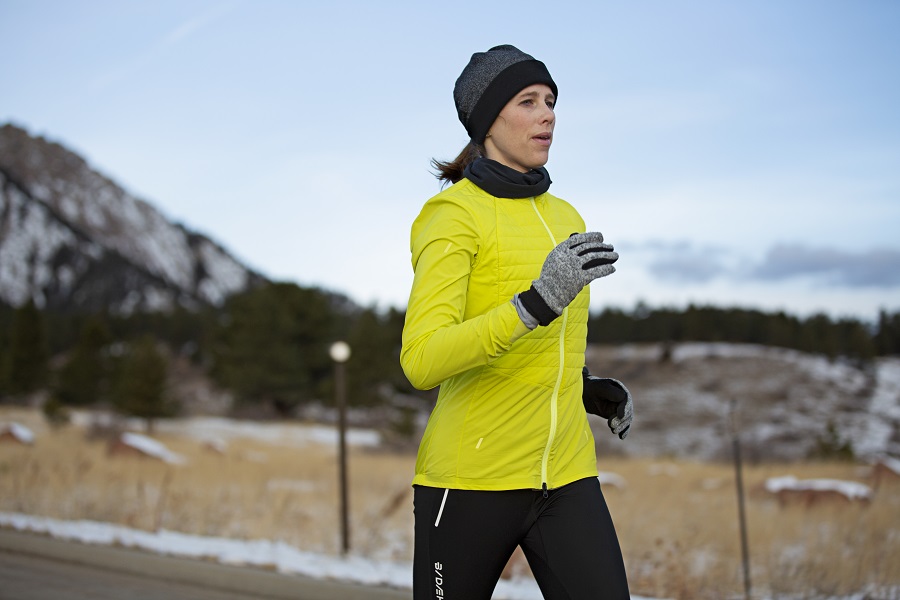
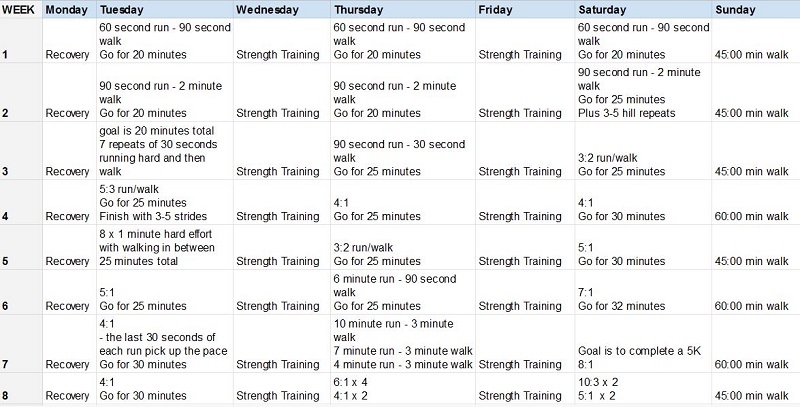
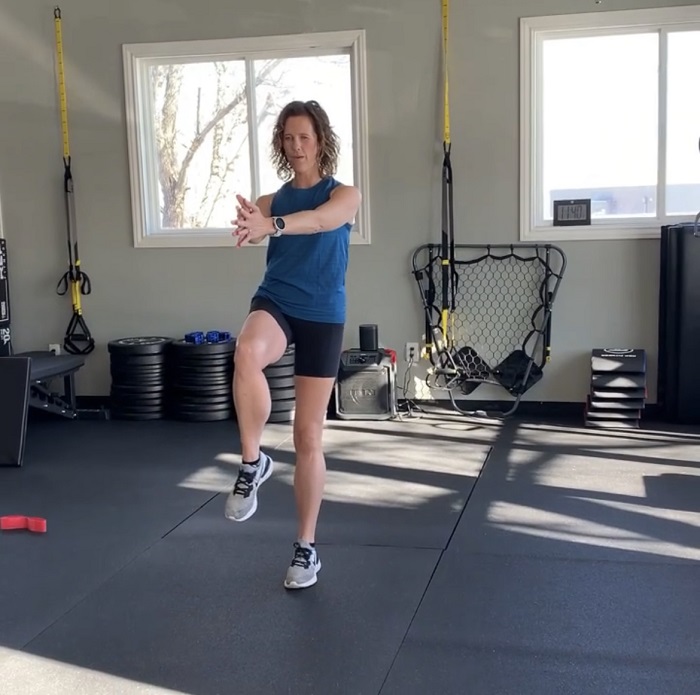
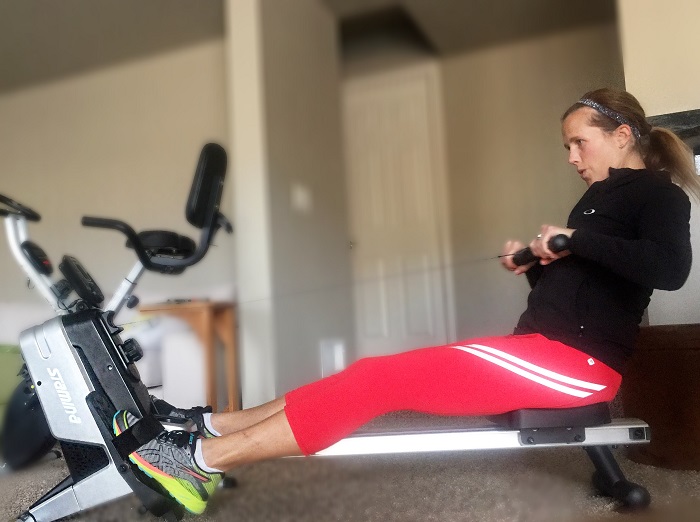

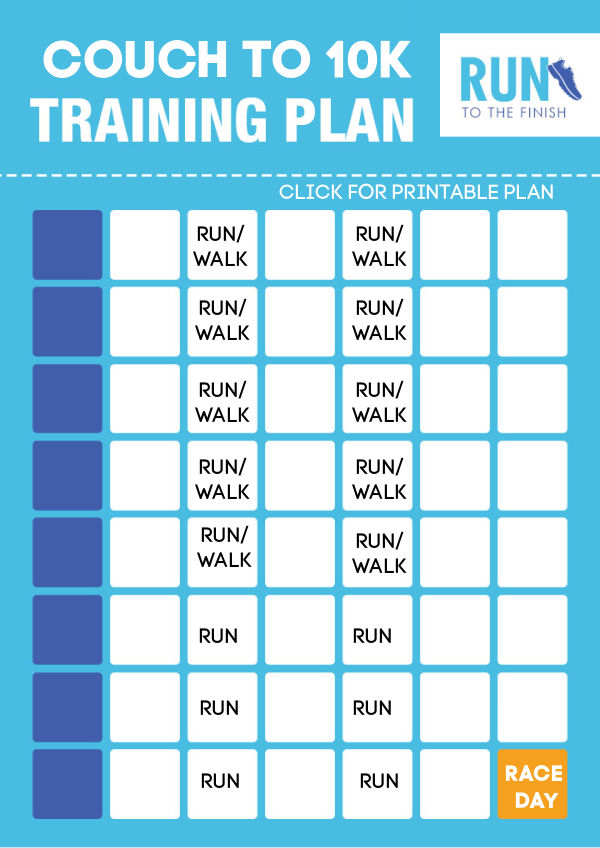
 Zero Drop Running Shoes: What Are They + Pros and Cons
Zero Drop Running Shoes: What Are They + Pros and Cons

Gergana
This is a great plan! I just started following it. However, I am not sure what “3-5 strides” means. Can you please explain? Thank you.
amanda
Absolutely! They’re a short pick up at the end of your run. Here’s a full explanation https://www.runtothefinish.com/running-strides/
Lauren
Just starting this plan and very excited! I’m curious about the hill repeats. How long should they be?
amanda
Here’s a good look at how to do them and incorporate! https://www.runtothefinish.com/hill-sprints/